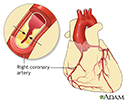Familial dysbetalipoproteinemia
Type III hyperlipoproteinemia; Deficient or defective apolipoprotein EFamilial dysbetalipoproteinemia is a disorder passed down through families. It causes high amounts of cholesterol and triglycerides in the blood.
Causes
A genetic variant causes this condition. The variant results in the buildup of large lipoprotein particles that contain both cholesterol and a type of fat called triglycerides. The disease is linked to variants in the gene for apolipoprotein E.
Hypothyroidism, obesity, or diabetes can make the condition worse. Risk factors for familial dysbetalipoproteinemia include a family history of the disorder or coronary artery disease.
Hypothyroidism
Hypothyroidism is a condition in which the thyroid gland does not make enough thyroid hormone. This condition is often called underactive thyroid....

Obesity
Overweight and obesity mean having a weight than is higher than what is healthy for a given height. A person may be overweight from extra muscle, bo...

Diabetes
Diabetes is a long-term (chronic) disease in which the body cannot regulate the amount of sugar in the blood.

Symptoms
Symptoms may not be seen until age 20 or older.
Yellow deposits of fatty material in the skin called xanthomas may appear on the eyelids, palms of the hands, soles of the feet, or on the tendons of the ankles, knees and elbows.
xanthomas
Xanthoma is a skin condition in which certain fats build up under the surface of the skin.

Other symptoms may include:
- Chest pain (angina) or other signs of coronary artery disease may be present at a young age
- Cramping of one or both calves when walking
- Sores on the toes that do not heal
- Sudden stroke-like symptoms such as trouble speaking, drooping on one side of the face, weakness of an arm or leg, and loss of balance
Exams and Tests
Tests that may be done to diagnose this condition include:
- Genetic testing for apolipoprotein E (apoE)
- Lipid panel blood test
-
Triglyceride level
Triglyceride level
The triglyceride level is a blood test to measure the amount of triglycerides in your blood. Triglycerides are a type of fat. Your body makes some t...
 ImageRead Article Now Book Mark Article
ImageRead Article Now Book Mark Article -
Very low density lipoprotein (VLDL) test
Very low density lipoprotein (VLDL) tes
VLDL stands for very low density lipoprotein. Lipoproteins are made up of cholesterol, triglycerides, and proteins. They move cholesterol, triglyce...
 ImageRead Article Now Book Mark Article
ImageRead Article Now Book Mark Article
Treatment
The goal of treatment is to control conditions such as obesity, hypothyroidism, and diabetes.
Making diet changes to reduce calories, saturated fats, and cholesterol may help lower blood cholesterol.
Making diet changes
A healthy diet is an important factor in reducing your risk for heart disease.

If cholesterol and triglyceride levels are still high after you have made diet changes, your health care provider may have you take medicines as well. Medicines to lower blood triglyceride and cholesterol levels include:
- Bile acid-sequestering resins.
- Fibrates (gemfibrozil, fenofibrate).
- Nicotinic acid.
- Statins.
- PCSK9 inhibitors, such as alirocumab (Praluent) and evolocumab (Repatha). These represent a newer class of medicines to treat cholesterol.
Outlook (Prognosis)
People with this condition have a significantly increased risk for coronary artery disease and peripheral vascular disease.
Coronary artery disease
Stable angina is chest pain or discomfort that most often occurs with activity or emotional stress. Angina is due to poor blood flow through the blo...

Peripheral vascular
Peripheral artery disease (PAD) is a condition of the blood vessels that supply the legs and feet. It occurs due to narrowing of the arteries in the...

With treatment, most people are able to greatly reduce their levels of cholesterol and triglycerides.
Possible Complications
Complications may include:
- Heart attack
- Stroke
- Peripheral vascular disease
- Intermittent claudication
- Gangrene of the lower extremities
When to Contact a Medical Professional
Contact your provider if you have been diagnosed with this disorder and:
- New symptoms develop.
- Symptoms do not improve with treatment.
- Symptoms get worse.
Prevention
Screening the family members of people with this condition may lead to early detection and treatment.
Getting treated early and limiting other risk factors such as smoking can help prevent early heart attacks, strokes, and blocked blood vessels.
References
Genest J, Mora S, Libby P. Lipoprotein disorders and cardiovascular disease. In: Libby P, Bonow RO, Mann DL, Tomaselli GF, Bhatt DL, Solomon SD, eds. Braunwald's Heart Disease: A Textbook of Cardiovascular Medicine. 12th ed. Philadelphia, PA: Elsevier; 2022:chap 27.
Robinson JG. Disorders of lipid metabolism. In: Goldman L, Cooney KA, eds. Goldman-Cecil Medicine. 27th ed. Philadelphia, PA: Elsevier; 2024:chap 190.
-
Coronary artery disease - illustration
The coronary arteries supply blood to the heart muscle itself. Blood supply through these arteries is critical for the heart. Coronary artery disease usually results from the build-up of fatty material and plaque, a condition called atherosclerosis. As the coronary arteries narrow, the flow of blood to the heart can slow or stop, causing chest pain (stable angina), shortness of breath, heart attack, or other symptoms.
Coronary artery disease
illustration
-
Coronary artery disease - illustration
The coronary arteries supply blood to the heart muscle itself. Blood supply through these arteries is critical for the heart. Coronary artery disease usually results from the build-up of fatty material and plaque, a condition called atherosclerosis. As the coronary arteries narrow, the flow of blood to the heart can slow or stop, causing chest pain (stable angina), shortness of breath, heart attack, or other symptoms.
Coronary artery disease
illustration
Review Date: 5/8/2024
Reviewed By: Thomas S. Metkus, MD, Assistant Professor of Medicine and Surgery, Johns Hopkins University School of Medicine, Baltimore, MD. Also reviewed by David C. Dugdale, MD, Medical Director, Brenda Conaway, Editorial Director, and the A.D.A.M. Editorial team.


